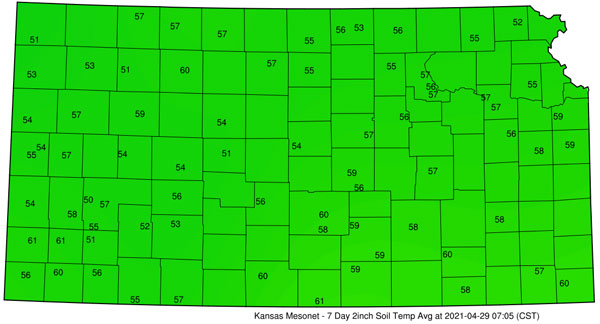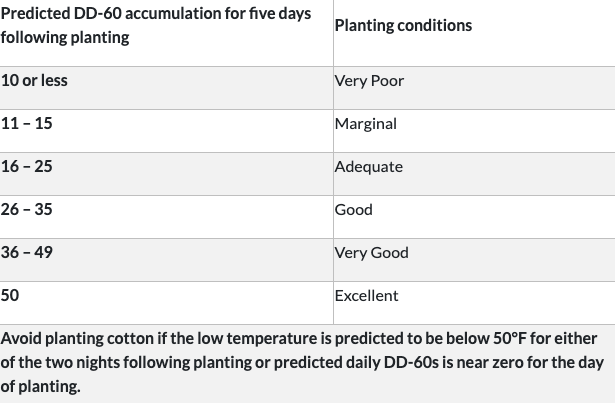First, much as with corn, the goal is to achieve an acceptably uniform and optimal stand. The recommended window for cotton planting is relatively narrow compared to that for other summer crops grown in Kansas – roughly May 1 through June 5.

However, it is best to monitor soil conditions rather than the calendar. You can monitor soil temperature information on the Kansas Mesonet ( http://mesonet.k-state.edu/agriculture/soiltemp/).
For a variety of reasons, including seedling chilling, potential herbicide injury, thrips and seedling diseases, it pays to plant when growers can not only get an adequate stand, but also when the crop will grow vigorously.
Soil temperature and the 10-day forecast are two major factors to that fast start.
Cotton seed germination and early growth/emergence is favored by soil temperatures above 64°F and adequate, but not excessive, soil moisture. Based on USDA-ARS research work at Lubbock, TX, the seedling cotton requires more than 100 hours above 64°F at the seed level to emerge.
In Kansas, we often use 60°F as our baseline temperature at seed level. Current 2-inch soil temperatures indicate that threshold is approaching, particularly in the Southwest (Figure 1). The 6-10 weather outlook favors cooler-than-normal temperatures for the period, which will slow warming of the soils.
In addition to considering soil temperature, growers should be planting high quality varieties (e.g. high cold germination and large seed size, with good cold tolerance and early season vigor ratings).
Information from North Carolina State University’s cotton web page illustrating the importance of heat unit accumulation immediately following planting is shown in Table 1.
Effects of Cold Soil
Cotton seed subjected to cold the first 2-3 days after planting, OR when the seed is imbibing moisture from the soil, is susceptible to imbibitional chilling injury.Cotton seed contains lipids which must be converted to energy, and cell membranes must develop properly.
If soil temperatures drop below 50°F during this critical germination period, seedlings may suffer damage. The first 30 minutes after planting, the seed will absorb up to 60% of the water necessary for germination.
Cold soil temperatures (<45°F to 50°F) will most likely lead to injury or seedling death. Damage may result in malformed seedlings, loss of or damage to the taproot, and a greater likelihood of seedling disease problems.Injury usually kills the root tip meristematic tissue which stops normal taproot growth and leads to lateral root development (Figure 2). If the plants survive, the root system will not develop normally.







Post a comment
Report Abusive Comment